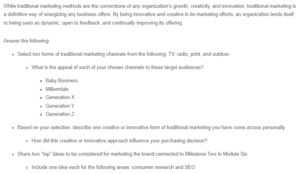Traditional Marketing Strategies
Baby boomers are the people that were born between 1946 and 1964. Baby boomers like listening to radios as the main channels to access information. About 76% of baby boomers listen to the radio. This is because public radio stations appeal to mature and highly educated listeners. Therefore, the radio comes first as the best marketing channel to reach the baby boomers (Vaughn, 2022). Like the radio, baby boomers like watching television. Thus, when firms want to reach those market segments, they must consider using televisions because it is estimated that baby boomers watch television three hours per day. Baby boomers prefer seeing adverts on television than on any other channel.
Millennials are people born between 1980 and 2000. While baby boomers watch TV and listen to the radio as their favorite channel, millennials stick to cable and local channels to watch programs. In other words, millennials prefer watching TV online and streaming videos. This group streams online TV more than any other generation. Therefore, online TV and video streaming are the best marketing challenges to reach them (Kasasa, 2021). Millennials are not interested in radio since the idea of radio is not appealing to them. Instead of listening to the radio, they listen to online music. Therefore, radio is not the best marketing challenge for a millennial market segment.
Generation X are people born between 1965 and 1980, and they make up the most significant purchasing power in the U.S. The radio is the most appealing marketing channel to Generation X. When they hear about a particular advert on the radio; they use search engines to search for the advertised goods online. Televisions do not very much appeal to Generation X because these people are in the middle of their practicing their careers and are very busy with business, jobs, and family life (Vaughn, 2022). Therefore, they have little time to sit and watch television. Instead, they can access news through small radios at their place of work and on the farms.
Generation Y are people born between 1997 to around 2010. This generation is characterized by heavy use of the internet. Television does not appeal much to this generation because they only watch television when there is a favorite program (Kasasa, 2021). However, they can still watch the program online. Generation Y is obsessed with the internet since they do everything on the internet. Radio, like television, does not appeal to them much since the only thing they can listen to on the radio is music. However, they still can listen to music online. Therefore, it is problematic for the generation to use television and radio and reach them.
Generation Z are the people born after 2010. These are young people in primary school. Televisions are the most appealing to this generation because they do not own gadgets such as mobile phones and computers to access online (Lewis, 2020). Thus, they watch television more often. Marketers can easily appeal to this generation by doing more eye-catching TV adverts. Generation Z is not much into the radio. The only thing they can listen to on the radio is music (Taylor, 2020). Therefore, radios are not the best marketing channels for this generation.
One of the creative or innovative advertisements on television is separating the adverts and programs section and posting them online. Many televisions nowadays create adverts and post them online, and thus, many people can watch them many times and share them overall. Earlier televisions were running adverts on the televisions only; the adverts would not be found on other platforms (Vaughn, 2022). However, the adverts currently appear on TV, but one can still find the same adverts online. If the advert is online, many people will see it thus increasing the purchasing traffic.
The two top ideas are digital marketing and differentiation. Search engine optimization could be employed to facilitate digital marketing. Product differentiation is a marketing strategy to make products unique from those of the competitors so that the consumers can quickly identify them. In other words, the differentiation of products in consumer research influences consumers’ buying behaviors.
References
Kasasa. (2021). Boomers, Gen X, Gen Y, Gen Z, and Gen A explained. Retrieved from https://www.kasasa.com/exchange/articles/generations/gen-x-gen-y-gen-z
Lewis, D. (2020). Marketing to Gen X: How Your E-commerce Strategy Can Successfully Convert Them. Retrieved from https://www.bigcommerce.com/blog/gen-x-marketing/#who-is-gen-x
Marketing Charts. (2020). Radio Ads Garner Gen X’s Attention. Retrieved from https://www.marketingcharts.com/demographics-and-audiences/youth-and-gen-x-69394
Taylor, R. (2020). How Gen Z and Millennials Watch Video Content & What That Means for Production Teams. Retrieved from https://www.rev.com/blog/how-gen-z-and-millennials-consume-video-content-what-that-means-for-production-teams
Vaughn, B. (2022). What Media Mix to Use for Your Target Audience to Maximize Advertising Results. Retrieved from https://clutch.co/agencies/digital/resources/what-media-mix-use-your-target-audience-maximize-advertising-results
ORDER A PLAGIARISM-FREE PAPER HERE
We’ll write everything from scratch
Question

Traditional Marketing Strategies
While traditional marketing methods are the cornerstone of any organization’s growth, creativity, and innovation, traditional marketing is a definitive way of energizing any business offers. By being innovative and creative in its marketing efforts, an organization lends itself to being seen as dynamic, open to feedback, and continually improving its offering.
Answer the following:
- Select two forms of traditional marketing channels from the following: TV, radio, print, and outdoor.
-
- What is the appeal of each of your chosen channels to these target audiences?
-
-
- Baby Boomers
- Millennials
- Generation X
- Generation Y
- Generation Z
-
- Based on your selection, describe one creative or innovative form of traditional marketing you have come across personally.
-
- How did this creative or innovative approach influence your purchasing decision?
- Share two “top” ideas to be considered for marketing the brand connected to Milestone Two in Module Six.
-
- Include one idea each for the following areas: consumer research and SEO.

